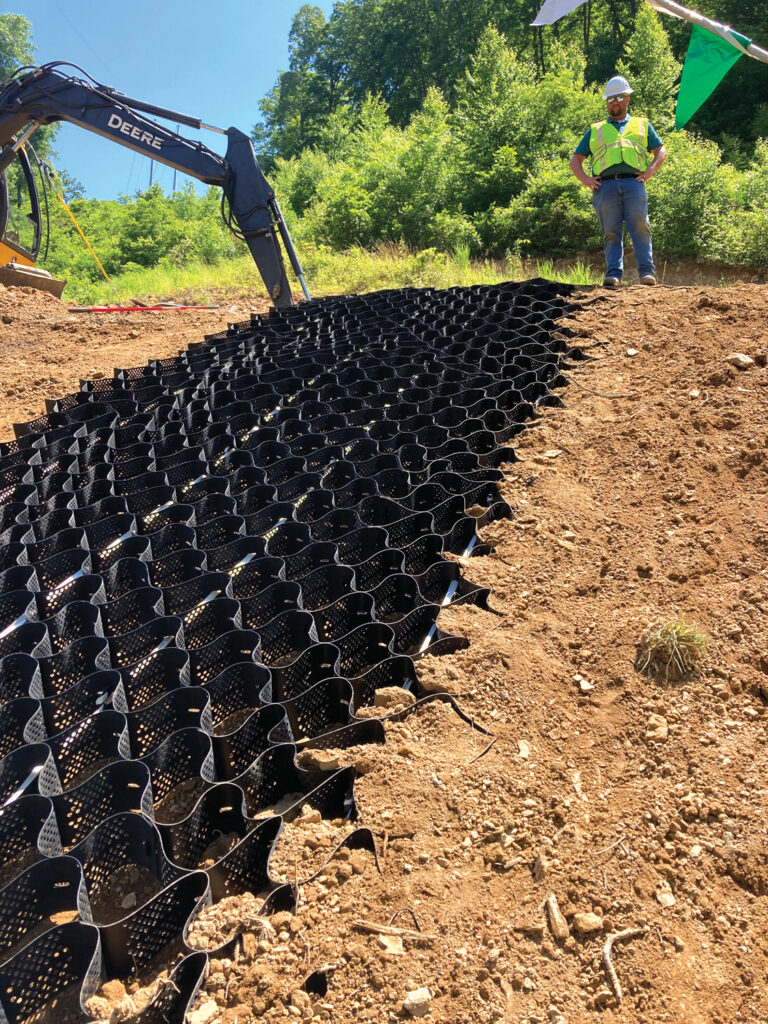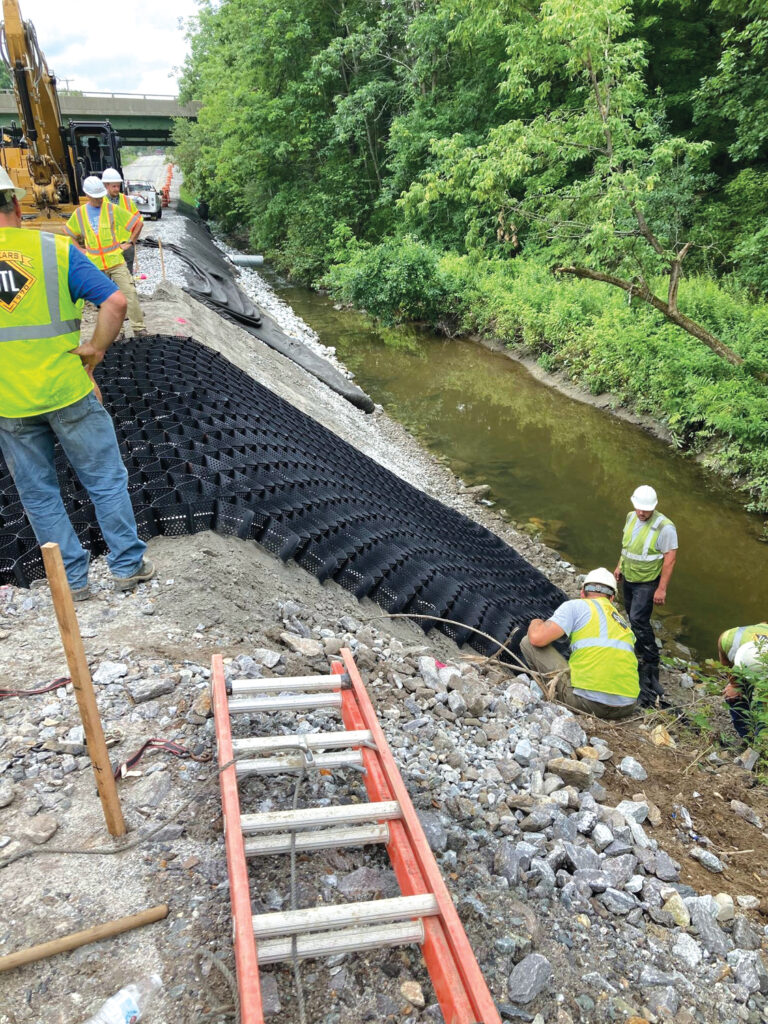
Erosion control is a critical challenge in environmental engineering, especially in areas where construction and landscaping alter the natural terrain. Geocell technology has emerged as an innovative solution to this problem. Geocells are three-dimensional, honeycomb-like structures made from geosynthetic materials, most commonly high-density polyethylene (HDPE). They are used to stabilize soil and prevent erosion by confining and reinforcing the soil within their cellular network. This technology is especially effective in areas where slopes are prone to erosion due to environmental factors like water runoff or wind.
Geocells are unique because they provide a flexible, permeable and durable structure that can be filled with various materials, including vegetation, aggregate, concrete or low-quality, on-site fill depending on the requirements of the project. This flexibility makes them ideal for a range of applications, from protecting embankments and shorelines to stabilizing roads and slopes. The following two case studies will explore how these concepts are applied in real-world scenarios, providing insight into their practical implications and effectiveness.
Case Study 1: Erosion control at Shelton Gardens Apartment Complex, Cincinnati, Ohio
Shelton Gardens, an apartment complex in Cincinnati, Ohio, recently faced a significant erosion control challenge. During renovations, including the construction of a new office, honeysuckle vegetation was removed from a nearby 20-foot high (6 m), 1.5:1 slope. This action increased the slope’s vulnerability to erosion, posing a threat to nearby sidewalks and parking lots.
Brad Ackel, an engineer from Carpenter Marty Transportation, supervised the project. To tackle the erosion issue, the team selected the GEOWEB® Slope Protection System with a 4-inch (10.2 cm) cell depth, which included tendon anchoring, a geotextile layer and topsoil infill to support vegetation growth. The project required the installation of 48,530 square feet (4,509 m2) of the GEOWEB System (Figure 2).
The GEOWEB Slope Protection System was chosen for its unique 3D cellular structure, which stabilizes and supports sustainable vegetation on slopes up to 45 degrees, and in some cases, even steeper. The system’s design provides superior surface stability against severe erosion caused by surface runoff and sheet flow, a feature not attainable with 2D planar systems. The confined infill within the geocells creates a structural surface layer resistant to sliding, with each cell forming a protected micro-environment that enhances resistance to erosive forces.

Installation and results
Diamond Excavation & Concrete LLC executed the installation work, which began on May 18 and ended on June 16, 2023. The team implemented the project in phases, deploying the pre-assembled (with tendons) GEOWEB System. The GEOWEB sections were connected using the patented ATRA® Keys, which are inserted through adjoining GEOWEB cell walls, turned and locked for the most secure connection.
The ATRA® Tendon Clips are used with tendons in the GEOWEB Slope Protection System to secure and stabilize the structure. The tendons, which are anchored at the crest of the slope, run through the GEOWEB cells and are connected using the ATRA Tendon Clips. These clips lock with the GEOWEB cell walls, providing a secure connection, while a looped tie-off ensures the tendons remain attached to the device. This setup is crucial in preventing the slope system from shifting, providing an effective erosion control solution.
The team cleared and graded the site, installed a geotextile, and then proceeded to install the tendon-equipped GEOWEB System. Installers anchored the system at the slope’s crest using a buried deadman anchor, earth anchor or a grouted steel eye bolt anchor with a minimum pull-out strength of 1,300 pounds (635 kg). Following this, they filled the GEOWEB System with topsoil using a slinger, hydroseeded the area, and finally, laid a turf reinforcement mat (TRM) for surface protection.
Despite initial unfamiliarity with the GEOWEB System, Diamond Excavation & Concrete, with field support from the local distributor, Meredith Brothers Inc., successfully installed the system. This project exemplifies the effectiveness of geocell technology in mitigating erosion risks and stabilizing slopes in urban settings, thereby ensuring the safety and integrity of adjacent infrastructure.
Case Study 2: River Road slope stabilization, Lewiston, Maine
River Road in Lewiston, Maine, is a beautiful route that meanders through lush landscapes. However, this charming road faced a significant challenge—a steep 1:1 slope—that posed stability and erosion concerns. Moreover, the road carried a heavy volume of traffic, including a constant flow of trucks. The combination of the slope’s steepness and the heavy traffic load created a high-risk scenario, necessitating an effective soil stabilization solution to ensure the long-term integrity and safety of the road.

Project challenges and solution
The project owners recognized the urgency to enhance the infrastructure and ensure the long-term safety of commuters, and the River Road reconstruction project was initiated. The project included shoulder widening, pavement reconstruction, milling, shimming and overlay. Additionally, efforts were made to reconstruct a gabion basket retaining wall, construct a stabilized vegetated slope, install an underdrain drainage system and replace the guardrail.
The reconstruction project encountered a significant challenge in constructing a vegetated slope with a 45-degree angle. This slope presented a heightened risk of erosion, particularly during the spring season when frequent rainfall and snowmelt would swell the brook at the toe of the slope. This would put the slope at a heighted risk of washing out.
The erosive forces posed a threat to the slope’s stability and the integrity of River Road itself. To mitigate these challenges, measures were required to reinforce the slope and establish an effective erosion control system, ensuring the long-term durability and safety of the road.
To accomplish this, the GEOWEB Slope Protection System with a vegetated infill was chosen as a soil stabilization and erosion control solution. The construction process involved the strategic use of geogrid lifts. The slope was built in lifts with geogrid layers placed periodically, creating a slope face with a steep 1:1 ratio. This method significantly enhances the overall stability of the slope (Figures 3 and 4).

Installation and results
To keep the topsoil in place on the steep slope, the GEOWEB System was used in combination with a tendon system. The GEOWEB System is a 3D cellular network specifically designed to stabilize topsoil, promoting sustainable vegetation growth even on slopes with an incline that can reach or even exceed 45 degrees. The system effectively mitigates the risk of severe erosion that can be caused by surface runoff or sheet flow, providing a level of slope-surface stability that 2D planar systems cannot match.
At the slope’s toe, the GEOWEB System was filled with rocks, creating a strong and stable foundation. Larger rocks were placed on top for additional support.
Moving up from the base of the slope, the cells within the GEOWEB System were filled with topsoil, creating a supportive and fertile environment for the growth of vegetation. This topsoil layer was then covered with a TRM, further reinforcing the structure and promoting the growth of a green cover on the slope.
Overall, the GEOWEB Slope Stabilization System played a vital role in this project, providing stability, soil confinement and vegetation support for the constructed slope.
Cory Schneider, MS has been a business development manager at Presto Geosystems for over 16 years. He specializes in distributor support, product development, and addressing regulatory and site challenges in civil engineering and construction. Additionally, he holds a master’s degree in environmental science and has extensive experience assisting with a variety of projects throughout the Western Hemisphere.
 TEXTILES.ORG
TEXTILES.ORG


